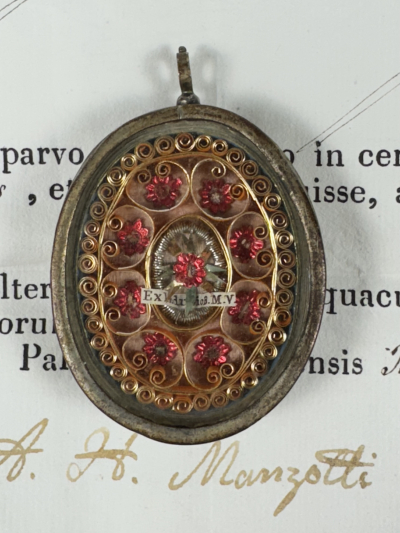According to tradition, the Veil of the Blessed Virgin Mary was worn by the Virgin as she stood at the foot of the Cross. It had been transferred in the early years of Christianity from Jerusalem to Constantinople when it was presented by the Byzantine Empress Irene to the Holy Roman Emperor Charlemagne. In 876 his descendant Charles the Bald gave the relic to the cathedral at Chartres. The Veil is kept in a golden reliquary beside the high altar and has formed the focus of many traditions throughout the centuries. It was believed to have protected the faithful down through the centuries from many dangers and evils, including famine and war, outbreaks of the plague, and the worst ravishes of the French Revolution. The veil itself is more than six meters long and made of silk. Scientific studies have shown that it is of Syrian design, of fine quality, and can be traced to the first century. Every year on 15th August, the Feast of the Assumption of Our Lady, the Veil is processed through the town of Chartres.
The earliest records of a formal devotional following for Saint Joseph date to the year 800 and reference to him as nutritor Domini (educator/guardian of the Lord). Together with the Blessed Virgin Mary and the Child Jesus, Joseph is one of the three members of the Holy Family. Of all the saints in Christendom, the only ones of whom we possess no ex ossibus (from the bone) relics are the Blessed Virgin Mary and her husband Saint Joseph. This lack of bodily relics is attributed to the Assumption of the Virgin Mary into heaven body and soul, which is one of the great Marian Dogmas of the Church. The same reasoning is applied to lack of bodily relics of Saint Joseph, Virgin-Father of Christ and Chaste Spouse of Mary.
Saint Ignatius of Loyola (†1556) was a Spanish Basque priest and theologian, who founded the religious order called the Society of Jesus (Jesuits) and became its first Superior General. Ignatius was beatified in 1609, and then canonized, receiving the title of Saint on March 12, 1622. His feast day is celebrated on July 31. He is the patron saint of the Basque provinces of Gipuzkoa and Biscay as well as the Society of Jesus, and was declared patron saint of all spiritual retreats by Pope Pius XI in 1922. Ignatius is also a foremost patron saint of soldiers.
Saint Anthony of Padua († 1231), also known as Anthony of Lisbon, was a Portuguese Catholic priest and friar of the Franciscan Order. Noted by his contemporaries for his powerful preaching, expert knowledge of scripture, and undying love and devotion to the poor and the sick, he was one of the most-quickly canonized saints in church history. He was canonized in 1232 by Pope Gregory IX and was proclaimed a Doctor of the Church in 1946. He is the patron saint of Lisbon, lost items, lost people, lost souls, American Indians; amputees; animals; Brazil; elderly people; faith in the Blessed Sacrament; fishermen; harvests; horses; lower animals; mail; mariners; oppressed people; poor people; Portugal; pregnant women; shipwrecks; starvation; sterility; swineherds; travel hostesses; and travelers. His feast day is celebrated on June 13.
Saint Peter († between AD 64 and 68), was one of the Twelve Apostles of Jesus Christ, leaders of the early Christian Church. He is also venerated as the "Apostle of the Apostles" and the first pope of the Roman Catholic Church, ordained by Jesus in the "Rock of My Church" dialogue in Matthew 16:18. The Christian churches all venerate Peter as a major saint and associate him with founding the Church of Antioch and later the Church in Rome. The Roman Martyrology assigns 29 June as the feast day of both Apostles Peter and Paul.
Saint Christina of Bolsena, also known as Christina of Tyre, or in the Eastern Orthodox Church as Christina the Great Martyr is venerated as a Christian martyr of the 3rd century. Toffia in the Province of Rieti displays her relics in a transparent urn. Palermo, of which Christina is one of four patron saints, also claims to hold her relics. The Eastern tradition connects Saint Christina with Tyre, Lebanon.
Saint Ursula (†383) is a Romano-British Christian saint. According to Tradition, she was a princess who set sail along with 11,000 virginal handmaidens to join her future husband, the pagan Governor Conan Meriadoc of Armorica. After a miraculous storm brought them over the sea in a single day to a Gaulish port, Ursula declared that before her marriage she would undertake a pan-European pilgrimage. She headed for Rome with her followers and persuaded the Pope, Cyriacus, and Sulpicius, bishop of Ravenna, to join them. After setting out for Cologne, which was being besieged by Huns, all the virgins were beheaded in a massacre. The Huns' leader fatally shot Ursula with an arrow in about 383 AD. She is a patron saint of Cologne, England, archers, orphans, students, Binangonan, Rizal.
Saint Aloysius Gonzaga, S.J. (Italian: Luigi Gonzaga; † 1591) was an Italian aristocrat who became a member of the Society of Jesus. While still a student at the Roman College, he died as a result of caring for the victims of an epidemic. He was beatified in 1605, and canonized in 1726. He is a patron of students, Christian youth, Jesuit scholastics, the blind, AIDS patients, AIDS caregivers.








 Поменять язык на русский
Поменять язык на русский 